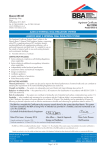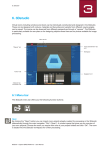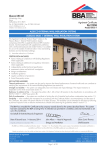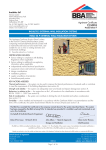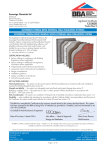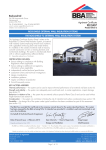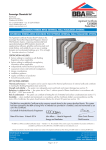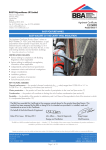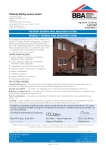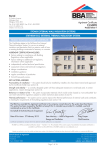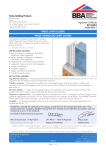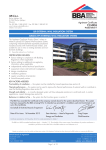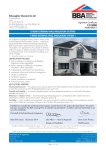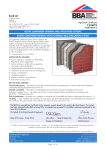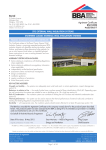Download Caparol UK CAPAROL EXTERNAL WALL INSULATION SYSTEMS
Transcript
APPROVAL INSPECTION TESTING CERTIFICATION Caparol UK Whitebridge Way Stone Staffordshire ST15 8JS Tel: 01785 811191 Fax: 01785 818144 TECHNICAL APPROVALS FOR CONSTRUCTION Agrément Certificate 13/5009 e-mail: info@caparol.co.uk website: www.caparol.co.uk Product Sheet 1 CAPAROL EXTERNAL WALL INSULATION SYSTEMS CAPAROL SYSTEM PRO AND CAPAROL SYSTEM CARBON EXTERNAL WALL INSULATION SYSTEMS This Agrément Certificate Product Sheet (1) relates to the Caparol System Pro and Caparol System Carbon External Wall Insulation Systems, comprising white EPS or graphite-enhanced EPS insulation boards, mechanically-fixed with supplementary adhesive, with a reinforced basecoat and render finishes. It is suitable for use on the outside of external walls in new and existing domestic and non-domestic buildings. (1) Hereinafter referred to as ‘Certificate’. CERTIFICATION INCLUDES: • factors relating to compliance with Building Regulations where applicable • factors relating to additional non-regulatory information where applicable • independently verified technical specification • assessment criteria and technical investigations • design considerations • installation guidance • regular surveillance of production • formal three-yearly review. KEY FACTORS ASSESSED Thermal performance — the system can be used to improve the thermal performance of external walls and can contribute to satisfying the requirements of the national Building Regulations (see section 6). Strength and stability — the system can adequately resist wind loads and impact-damage. The impact resistance is dependent on the finish chosen (see section 7). Behaviour in relation to fire — the system has either a B-s1, d0 or B-s2, d0 reaction to fire classification in accordance with BS EN 13501-1 : 2007 (see section 8). Risk of condensation — the system can contribute to limiting the risk of interstitial and surface condensation (see section 11). Durability — when installed and maintained in accordance with the Certificate holder’s recommendations and the terms of this Certificate, the system will remain effective for at least 30-years. The durability can be extended to 60-years by following a planned inspection and an effective maintenance schedule and observing the guidelines stated in section 13. The BBA has awarded this Certificate to the company named above for the system described herein. This system has been assessed by the BBA as being fit for its intended use provided it is installed, used and maintained as set out in this Certificate. On behalf of the British Board of Agrément Date of Second issue: 8 July 2014 John Albon — Head of Approvals Claire Curtis-Thomas Originally certificated on 7 June 2013 Energy and Ventilation Chief Executive The BBA is a UKAS accredited certification body — Number 113. The schedule of the current scope of accreditation for product certification is available in pdf format via the UKAS link on the BBA website at www.bbacerts.co.uk Readers are advised to check the validity and latest issue number of this Agrément Certificate by either referring to the BBA website or contacting the BBA direct. British Board of Agrément Bucknalls Lane Watford Herts WD25 9BA ©2014 Page 1 of 19 tel: 01923 665300 fax: 01923 665301 e-mail: mail@bba.star.co.uk website: www.bbacerts.co.uk Regulations In the opinion of the BBA, Caparol System Pro and Caparol System Carbon External Wall Insulation Systems, if installed, used and maintained in accordance with the provisions of this Certificate, can satisfy or contribute to satisfying the relevant requirements of the following Building Regulations (the presence of a UK map indicates that the subject is related to the Building Regulations in the region or regions of the UK depicted): The Building Regulations 2010 (England and Wales) (as amended) Requirement: A1 Loading Comment: Requirement: B4(1) External fire spread Comment: Requirement: C2(b) Resistance to moisture The system can sustain and transmit wind loads to the substrate wall. See section 7.4 of this Certificate. The system can meet this Requirement. See sections 8.1 to 8.4 of this Certificate. Comment: The system provides a degree of protection against rain ingress. See sections 4.4 and 10.1 of this Certificate. Requirement: C2(c) Resistance to moisture Comment: The system can contribute to minimising the risk of interstitial and surface condensation. See sections 11.1, 11.2 and 11.4 of this Certificate. Requirement: L1(a)(i) Conservation of fuel and power Comment: Regulation: 7 Materials and workmanship Comment: Regulation: Regulation: 26 26A CO2 emission rate for new buildings Fabric energy efficiency rates for new dwellings (applicable to England only) The system can contribute to satisfying this Requirement. See sections 6.2 and 6.3 of this Certificate. The system is acceptable. See sections 13.1 and 13.2 and the Installation part of this Certificate. The system can contribute to satisfying these Regulations. See sections 6.2 and 6.3 of this Certificate. Comment: The Building (Scotland) Regulations 2004 (as amended) Regulation: 8(1)(2) Durability, workmanship and fitness of materials The system can contribute to the construction satisfying this Regulation. See sections 12, 13.1 and 13.2 and the Installation part of this Certificate. Comment: Regulation: Standard: 9 1.1 Building standards applicable to construction Structure Comment: Standard: 2.6 Spread to neighbouring buildings The system can sustain and transmit wind loads to the substrate wall. See section 7.4 of this Certificate. The external surface of the system is classified as ‘low risk’, with reference to clauses 2.6.4(1)(2), 2.6.5(1) and 2.6.6(2). See sections 8.1 to 8.6 of this Certificate. Comment: Standard: 2.7 Standard: 3.10 3.15 6.1(b) 6.2 7.1(a)(b) Statement of sustainability The system can contribute to satisfying the relevant requirements of Regulation 9, Standards 1 to 6, and, therefore, will contribute to a construction meeting the bronze level of sustainability as defined in this Standard. In addition, the product can contribute to a construction meeting a higher level of sustainability as defined in this Standards, with reference to clauses 7.1.4(1)(2) [Aspect 1(1)(2) and 2(1)], 7.1.6(1)(2) [Aspect 1(1)(2) and 2(1)] and 7.1.7(1)(2) [Aspect 1(1)(2)]. See section 6.2 of this Certificate. Comment: Regulation: Carbon dioxide emissions Buildings insulation envelope The system can contribute to satisfying these Standards, with reference to clauses 6.1.1(1)(2), 6.1.2(1)(2), 6.1.3(1), 6.1.6(1), 6.2.10(2), 6.2.1(1)(2), 6.2.3(1), 6.2.4(2), 6.2.5(2), 6.2.6(1), 6.2.7(1), 6.2.8(2), 6.2.9(1)(2), 6.2.10(1), 6.2.11(1), 6.2.12(2) and 6.2.13(1)(2). See sections 6.2 and 6.3 of this Certificate. Comment: Standard: Condensation The system will satisfy the requirements of this Standard, with reference to clauses 3.15.1(1)(2), 3.15.4(1)(2) and 3.15.5(1)(2). See sections 11.3 and 11.4 of this Certificate. Comment: Standard: Standard: Precipitation The system will contribute to a construction satisfying this Standard, with reference to clauses 3.10.1(1)(2) and 3.10.2(1)(2). See sections 4.4 and 10.1 of this Certificate. Comment: Standard: Spread on external walls The external surface of the system is classified as ‘low risk’, with reference to clauses 2.7.1(1)(2) and 2.7.2(1)(2) and Annex 2A(1). See sections 8.1 to 8.6 of this Certificate. Comment: 12 Building standards applicable to conversions All comments given for the system under Regulation 9, Standards 1 to 6, also apply to this Regulation, with reference to 0.12.1(1)(2) and Schedule 6(1)(2). Comment (1) Technical Handbook (Domestic). (2) Technical Handbook (Non-Domestic). The Building Regulations (Northern Ireland) 2012 Regulation: Comment: 23 Fitness of materials and workmanship The system is acceptable. See sections 13.1 and 13.2 and the Installation part of this Certificate. Page 2 of 19 Regulation: 28(b) Resistance to moisture and weather Comment: Regulation: 29 Condensation The system provides a degree of protection against rain ingress. See sections 4.4, 10.1 of this Certificate. The system can contribute to minimising the risk of interstitial and surface condensation. See sections 11.2 and 11.4 of this Certificate. Comment: Regulation: 30 Stability Comment: Regulation: 36(a) External fire spread Comment: Regulation: 39(a)(i) Conservation measures Comment: Regulation: 40 Target carbon dioxide emission rate The system can sustain and transmit wind loads to the substrate wall. See section 7.4 of this Certificate. The system can meet this Regulation. See sections 8.1 to 8.4 of this Certificate. The system can contribute to satisfying this Regulation. See sections 6.2 and 6.3 of this Certificate. Comment: The system can contribute to satisfying this Regulation. See sections 6.2 and 6.3 of this Certificate. Construction (Design and Management) Regulations 2007 Construction (Design and Management) Regulations (Northern Ireland) 2007 Information in this Certificate may assist the client, CDM co-ordinator, designer and contractors to address their obligations under these Regulations. See section: 3 Delivery and site handling (3.2 and 3.4) of this Certificate. Additional Information NHBC Standards 2014 NHBC accepts the use of the Caparol System Pro and Caparol System Carbon External Wall Insulation Systems, provided it is installed, used and maintained in accordance with this Certificate, in relation to NHBC Standards, Part 6 Superstructure (excluding roofs), Chapter 6.9 Curtain walling and cladding. Technical Specification 1 Description 1.1 The Caparol System Pro and Caparol System Carbon External Wall Insulation Systems (see Figure 1) comprises, from inside to outside: Adhesive — Caparol System Adhesive — cement-based adhesives, comprising limestone sand conforming to BS EN 13139 : 2002, cement conforming to BS EN 197-1 : 2011 and additives. Supplied as a powder to which clean water is added. Insulation — white expanded polystyrene insulation boards (Caparol EPS 038 and Caparol EPS 037) and graphite-enhanced polystyrene insulation boards (Caparol EPS 030, Caparol EPS 031 and Caparol EPS 032) (see Table 3 of this Certificate). Each available in sizes up to 1200 mm by 600 mm in a range of thicknesses from 20 mm to 400 mm in increments of 10 mm, with a nominal density of 15 kg·m–3, a minimum compressive strength of 70 kN·m–2 and tensile resistance of 100 kN·m–2. Boards are manufactured so as to comply with the requirements for type FRA (flame retardant additive) material to BS EN 13163 : 2012. Mechanical fixings — mechanical fixings(1) — anchors with adequate length to suit the substrate and the insulation thickness and selected from: Ejot STR U — polyethylene, PE-HD with steel or electro-galvanized pins Ejot SDK U — polyethylene, PE-HD with steel or electro-galvanized pins Ejot NK U — polyethylene, PE-HD with steel or electro-galvanized pins Ejot NTK U — polyethylene, PE-HD with polyamide or PA pins SDF–K plus — polyamide with steel or electro-galvanized pins Termoz WS 8N — polyamide with steel or electro-galvanized pins. (1) Other fixings may be used provided they can be demonstrated to have equal or higher pull-out and plate stiffness characteristics. Basecoat — Caparol System Pro Base, Caparol System Carbon Base — basecoats, comprising limestone sand conforming to BS EN 13139 : 2002, cement conforming to BS EN 197-1 : 2011 and additives. Supplied as a powder to which clean water is added. Reinforcement — Caparol System Mesh — 1.10 m wide mesh (4 mm by 4 mm) of multi-stranded alkali-resistant glassfibres, with a polymer coating and a nominal weight of 160 g·m–2. Page 3 of 19 Primer — Caparol System Top Primer P, Caparol System Top Primer Sc — acrylic-based emulsions containing fine fillers, pigment and a coalescing agent, used as a bonding medium and pre-coat to control suction. Render finish — Caparol System Carbon Plaster Finish — pre-coloured, ready-mixed, silicone-based, textured coatings — Caparol System Pro Plaster — pre-coloured render, comprising limestone sand conforming to BS EN 13139 : 2002, cement conforming to BS EN 197-1 : 2011 and polymers. Supplied as a powder to which clean water is added. Figure 1 Caparol System Pro and Caparol System Carbon External Wall Insulation Systems substrate adhesive expanded polystyrene insulation board mechanical fixing glassfibre mesh embedded in basecoat primer decorative render finish 1.2 Ancillary materials also used with the system but outside of the scope of this Certificate: • Caparol profiles, comprising: — aluminium, PVC-U or stainless steel base profile — aluminium, PVC-U or stainless steel edge profile — aluminium, PVC-U or stainless steel corner profile with optional PVC-U nosing — aluminium, PVC-U or stainless steel render stop profile — aluminium, PVC-U or stainless steel movement joint — aluminium, PVC-U or stainless steel expansion joint • Caparol profile connectors and fixings • Caparol sealing tape — precompressed expanding polyurethane foam tape • Caparol acrylic-based joint sealant • Caparol PU foam. 1.3 The insulation boards are fixed to the external surface of the wall using mechanical fixings and Caparol System Adhesive (as necessary). The insulation boards are protected by a basecoat containing a glassfibre reinforcement mesh. After allowing the basecoat to dry, primer and topcoat is applied to the required thickness. Page 4 of 19 Table 1 Caparol System Pro and Caparol System Carbon system summary Component Product Caparol System Pro Caparol System Carbon Adhesive Caparol System Adhesive Caparol System Adhesive Insulation white EPS graphite-enhanced EPS white EPS graphite-enhanced EPS Basecoat Caparol System Pro Base Caparol System Carbon Base Reinforcement Primer Render finish Caparol System Mesh Caparol System Mesh Caparol System Top Primer P Caparol System Top Primer Sc Caparol System Pro Plaster Caparol System Carbon Plaster Finish 2 Manufacture 2.1 Components are manufactured by the Certificate holder or bought-in from suppliers, to an agreed specification. 2.2 As part of the assessment and ongoing surveillance of product quality, the BBA has: • agreed with the manufacturer the quality control procedures and product testing to be undertaken • assessed and agreed the quality control operated over batches of incoming materials • monitored the production process and verified that it is in accordance with the documented process • evaluated the process for management of nonconformities • checked that equipment has been properly tested and calibrated • undertaken to carry out the above measures on a regular basis through a surveillance process, to verify that the specifications and quality control operated by the manufacturer are being maintained. 2.3 The management system of Caparol (UK) Ltd has been assessed and registered as meeting the requirements of BS EN ISO 9001 : 2008 by SQS (Certificate 37528). 3 Delivery and site handling 3.1 The insulation is delivered wrapped in polythene. Each pack carries the product identification and batch numbers. 3.2 The other components are delivered to site in the quantities and packaging listed in Table 2. Each package carries the product identification and manufacturer’s batch number. Table 2 Component supply details Component Quantity and packaging adhesive 25 kg paper bag or polythene tub Caparol System Mesh 1.10 m wide roll, 50 m length primer 10 litre or 15 litre plastic drum basecoat/render finish 25 kg polyethylene bag, drum or paper bag fixings boxed by manufacturer 3.3 The insulation should be stored on a firm, clean, level base, off the ground and under cover until required for use. Care must be taken when handling the insulation to avoid damage. 3.4 The insulation boards must be protected from prolonged exposure to sunlight, either by storing opened packs under cover or re-covering with opaque polythene sheeting. Care must be taken to avoid contact with solvents or materials containing volatile organic components. The boards must not be exposed to open flame or other ignition sources. 3.5 The powder and paste components must be stored in a safe area, in dry conditions, off the ground, and be protected from excessive heat, moisture and frost. Contaminated materials should be discarded. Assessment and Technical Investigations The following is a summary of the assessment and technical investigations carried out on the Caparol System Pro and Caparol System Carbon External Wall Insulation Systems. Design Considerations 4 General 4.1 The Caparol System Pro and Caparol System Carbon External Wall Insulation Systems, when installed in accordance with this Certificate, is effective in reducing the thermal transmittance (U value) of walls of new and existing buildings. It is essential that the detailing techniques specified in this Certificate are carried out to a high standard if the ingress of water into the insulation is to be avoided and the full thermal benefit obtained from treatment with the system. Only details specified by the Certificate holder should be used. Page 5 of 19 4.2 The system will improve the weather resistance of a wall and provide a decorative finish. However, it should only be installed where there are no signs of dampness on the inner surface of the wall other than those caused solely by condensation. 4.3 The system is for application to the outside of external walls of masonry, or dense or no-fines concrete construction, either with or without render on new or existing domestic and non-domestic buildings up to 18 metres in height. Prior to installation of the system, the wall surfaces should comply with section 14 of this Certificate. 4.4 New walls subject to national Building Regulations should be constructed in accordance with the relevant recommendations of: • BS EN 1996-2 : 2006, in that the designer should select a construction appropriate to the local wind-driven rain index, paying due regard to the design detailing, workmanship and materials to be used • BS 8000-3 : 2001. 4.5 Other new buildings not subject to regulatory requirements should also be built in accordance with the Standards identified in section 4.4. 4.6 The effect of the installation of the insulation system on the acoustic performance of a construction is outside the scope of this Certificate. 4.7 The fixing of rainwater goods, satellite dishes, clothes lines, hanging baskets and similar items is outside the scope of this Certificate. 4.8 External plumbing should also be removed before installation and alterations made to underground drainage, where appropriate, to accommodate repositioning of the plumbing to the finished face of the system. 4.9 It is essential that the insulation system is installed and maintained in accordance with the conditions set out in this Certificate. 5 Practicability of installation The system should only be installed by specialised contractors who have successfully undergone training and registration by the Certificate holder. Note: The BBA operates a UKAS Accredited Approved Installer Scheme for external wall insulation; details of approved installer companies are included on the BBA’s website (www.bbacerts.co.uk). 6 Thermal performance 6.1 Calculations of thermal transmittance (U value) should be carried out in accordance with BS EN ISO 6946 : 2007 and BRE Report 443 : 2006, using the declared thermal conductivity of the insulation (D value), given in Table 3. Table 3 Thermal conductivity of the insulation (D value) Insulation types Thicknesses (mm) Thermal conductivity (W·m–1·K–1) White EPS Caparol EPS 038 Caparol EPS 037 20 to 400 0.038 0.037 Graphite-enhanced EPS Caparol EPS 030 Caparol EPS 031 Caparol EPS 032 20 to 400 0.030 0.031 0.032 6.2 The U value of a completed wall will depend on the selected insulation thickness, the fixing method, the insulating value of the substrate masonry and its internal finish. Calculated U values for example constructions are given in Tables 4 and 5. Page 6 of 19 Table 4 Insulation thickness required to achieve U value (1)(2)(3) using galvanized steel fixings (30-year durability) Thickness of insulation (mm) U value (W·m–2·K–1) White White GraphiteGraphiteGraphiteEPS EPS enhanced EPS enhanced EPS enhanced EPS 0.038 0.037 0.032 0.031 0.030 White White GraphiteGraphiteGraphiteEPS EPS enhanced EPS enhanced EPS enhanced EPS 0.038 0.037 0.032 0.031 0.030 215 mm Brickwork, = 0.56 W·m–1·K–1 200 mm Dense blockwork, = 1.75 W·m–1·K–1 0.19 210 210 180 170 170 220 210 190 180 180 0.25 150 150 130 120 120 160 160 140 130 130 0.26 140 140 120 120 120 150 150 130 130 120 0.28 130 130 110 110 110 140 140 120 120 110 0.30 120 120 100 100 100 130 130 110 110 100 0.35 100 100 90 80 80 110 110 90 90 90 (1) Wall construction inclusive of 13 mm plaster ( = 0.57 W·m ·K ), 5 mm render ( = 1.0 W·m ·K ). Brickwork (protected) with 17.1% mortar or dense blockwork with 6.7% mortar ( = 0.88 W·m–1·K–1). EPS insulation D (as per Table 3). (2) Calculation based on a system that included seven galvanized steel fixings, with 8 mm diameter and point thermal transmittance (Xp = 0.004 W·K–1) per m2. Use of other types of fixings should be calculated in accordance with BS EN ISO 6946 : 2007. (3) Based upon incremental insulation thickness of 10 mm. –1 –1 –1 –1 Table 5 Insulation thickness required to achieve U value (1)(2)(3) using stainless steel fixings (60-year durability) Thickness of insulation (mm) U value (W·m–2·K–1) White White GraphiteGraphiteGraphiteEPS EPS enhanced EPS enhanced EPS enhanced EPS 0.038 0.037 0.032 0.031 0.030 White White GraphiteGraphiteGraphiteEPS EPS enhanced EPS enhanced EPS enhanced EPS 0.038 0.037 0.032 0.031 0.030 215 mm Brickwork, = 0.56 W·m–1·K–1 200 mm Dense blockwork, = 1.75 W·m–1·K–1 0.19 190 190 160 160 150 200 200 170 170 160 0.25 140 140 120 120 110 150 150 130 120 120 0.26 140 130 110 110 110 140 140 120 120 120 0.28 120 120 110 100 100 130 130 110 110 110 0.30 110 110 100 90 90 120 120 100 100 100 100 90 80 80 80 100 100 90 90 80 0.35 (1) (2) (3) Wall construction inclusive of 13 mm plaster ( = 0.57 W·m–1·K–1), 5 mm render ( = 1.0 W·m–1·K–1). Brickwork (protected) with 17.1% mortar or dense blockwork with 6.7% mortar ( = 0.88 W·m–1·K–1). EPS insulation D (as per Table 3). Calculation based on a system that included seven stainless steel fixings, with 8 mm diameter and point thermal transmittance (Xp = 0.002 W K–1) per m2. Use of other types of fixings should be calculated in accordance with BS EN ISO 6946 : 2007. Based upon incremental insulation thickness of 10 mm. 6.3 The system can maintain, or contribute to maintaining, continuity of thermal insulation at junctions between external walls and junctions. Details shown in section 16 will allow use of the default -values (Psi) for Accredited Construction Details in Emission Rate calculations to SAP 2009 or the Simplified Building Energy Model (SBEM). Guidance on limiting heat loss at junctions can be found in: England and Wales — Approved Documents to Part L and, for new thermal elements to existing buildings, Accredited Construction Details (version 1.0). For new-build, see also SAP 2009, Appendix K, and the iSBEM User Manual Scotland — Accredited Construction Details (Scotland) Northern Ireland — Accredited Construction Details (version 1.0). 7 Strength and stability General 7.1 When installed on suitable walls, the system can adequately transfer to the wall the self-weight and negative (suction) and positive (pressure) wind loads normally experienced in the United Kingdom. 7.2 Positive wind load is transferred to the substrate wall directly via bearing and compression of the render and insulation. 7.3 Negative wind pressure is resisted by the bond between each component. The insulation boards are retained by the external wall insulation system anchors. 7.4 The wind loads on the walls should be calculated in accordance with BS EN 1991-1-4 : 2005. Special consideration should be given to locations with high wind-load pressure coefficients, as additional fixings may be necessary. In accordance with BS EN 1990 : 2002, it is recommended that a load factor of 1.5 is used to determine the ultimate wind load to be resisted by the system. Page 7 of 19 7.5 Assessment of structural performance for individual installations should be carried out by a suitably qualified and experienced individual to confirm that: • the substrate wall has adequate strength to resist the additional loads that may be applied as a result of installing the system, ignoring any positive contribution that may occur from the system • the proposed system and associated fixing layout provides adequate resistance to negative wind loads, based on the results of site investigation and test results • an appropriate number of site-specific pull-out tests are conducted on the substrate of the building to determine the minimum resistance to failure of the fixings. The characteristic pull-out resistance should be determined in accordance with the guidance given in ETAG 014 : 2011, Annex D. 7.6 The number and centres of fixings should be determined by the system designer. Provided the substrate wall is suitable and an appropriate fixing is selected, the mechanical fixings will adequately support and transfer the weight of the render insulation system to the substrate wall at the minimum spacing given in this Certificate. 7.7 Typical characteristic pull-out strengths for the fixings taken from the corresponding European Technical Approval (ETA) are given in Table 6; however, these values are dependent on the substrate, and the fixing must be selected to suit the loads and substrate concerned. Table 6 Fixings — typical characteristic pull-out strengths Fixing type ETA number Substrates Drill diameter (mm) Embedment depth (mm) Typical pull-out strength (kN) Ejot STR U 04/0023 Concrete/brick 8 25 1.5/1.5 Ejot SDK U 04/0023 Concrete/brick 8 25 1.5/1.5 Ejot NK U 05/0009 Concrete/brick 8 25 1.2/1.5 Ejot NTK U 07/0026 Concrete/brick 8 40 0.6/0.9 SDF-K plus 04/0064 Concrete/brick 8 60 1.5/1.5 Termoz WS 8N 03/0019 Concrete/brick 8 50 1.5/1.2 7.8 The resistance forces data given in Table 7 are the results of calculations based upon pull-through resistances determined by the BBA from tests on anchors with 60 mm and 90 mm diameter plates. Table 7 Design pull-through resistances Factor Insulation Graphite enhanced/white EPS 60 90 100 100 60 90 Characteristic pull-through resistance per anchor (N) 415 450 Factor of safety 2.5 2.5 166 180 Thickness (mm) Tensile resistance of insulation (kPa) Plate diameter of anchor (mm) (1) Design pull-through resistance (N) (2) (1) Pull-through resistance of insulation over the head of the fixing. (2) The safety factor of 2.5 is based on the assumption that all insulation boards are quality controlled and tested to establish tensile strength perpendicular to the face of the slab. Impact resistance 7.9 Hard body impact tests were carried out in accordance with ETAG 004 : 2013. The system can be classed as having Use Categories I to III(1), as shown in Table 8. Table 8 Use Categories Rendering system (basecoat with finishing coats) Single, standard mesh Caparol System Carbon Plaster Finish Category II Caparol System Pro Plaster (1) The use categories are defined in ETAG 004 : 2013 as: • Category I — a zone readily accessible at ground level to the public and vulnerable to hard body impacts but not subjected to abnormally rough use • Category II — a zone liable to impacts from thrown or kicked objects, but in public locations where the height of the system will limit the size of the impact; or at lower levels where access to the building is primarily to those with some incentive to exercise care. • Category III — a zone not likely to be damaged by normal impacts caused by people or by thrown or kicked objects. Page 8 of 19 8 Behaviour in relation to fire 8.1 The reaction to fire classification for the system is as indicated in Table 9, in accordance with BS EN 13501-1 : 2007. Table 9 System fire classifications Rendering system Classification Caparol System Pro Plaster B-s1, d0 Caparol System Carbon Plaster Finish B-s2, d0 8.2 The fire classification applies to the full range of thicknesses covered by this Certificate. 8.3 The system is restricted for use in buildings up to 18 metres in height. 8.4 For houses in Scotland, and for all buildings in England and Wales and Northern Ireland, the system is suitable for use on, or at any distance from, the boundary. 8.5 For flats and maisonettes and non-domestic buildings in Scotland, the system is suitable only for use more than one metre from the boundary. 8.6 The system is not classified as ‘non-combustible; therefore, calculations for unprotected areas may apply dependent on the fire resistance characteristics of the wall. 8.7 For application to second storey walls and above, it is recommended that the designer considers at least one stainless steel fixing per square metre and fire barriers in line with compartment walls and floors as advised in BRE Report BR 135 : 2013 (see Figure 2). Figure 2 Fire barrier details substrate adhesive mortar EPS insulation board fire break position in conjunction with floor construction 200 mm continuous strip of Lamella Mineral Wool (fire class 0) basecoat and reinforced mesh 9 Proximity of flues and appliances Where a system is installed in close proximity to certain flue pipes, the relevant provisions of the national Building Regulations should be met: England and Wales — Approved Document J Page 9 of 19 Scotland — Mandatory Standard 3.19, clause 3.19.4(1)(2) (1) Technical Handbook (Domestic). (2) Technical Handbook (Non-Domestic). Northern Ireland — Technical Booklet L. 10 Water resistance 10.1 The system will provide a degree of protection against rain ingress. Care should be taken to ensure that walls are adequately weathertight prior to application of the system. The insulation system shall only be installed where there are no signs of dampness on the inner surface of the substrate other than those caused solely by condensation. 10.2 Designers and installers should take particular care in detailing around openings, penetrations and movement joints to minimise the risk of rain ingress. 10.3 Guidance given in BRE Report 262 : 2002 should be followed in connection with the weathertightness of solid wall constructions. The designer should select a construction appropriate to the local wind-driven rain index, paying due regard to the design detailing, workmanship and materials to be used. 10.4 At the tops of walls, the system should be protected by an adequate overhang or other detail designed for use with this type of system (see section 16). 11 Risk of condensation 11.1 Designers must ensure that an appropriate condensation risk analysis has been carried out for all parts of the construction, including openings and penetrations at junctions between the insulation system and windows, to minimise the risk of condensation. The recommendations of BS 5250 : 2011 should be followed. Surface condensation 11.2 Walls will limit the risk of surface condensation adequately when the thermal transmittance (U value) does not exceed 0.7 W·m–2·K–1 at any point and the junctions with other elements and openings comply with section 6.3 of this Certificate. 11.3 Walls will adequately limit the risk of surface condensation when the thermal transmittance (U value) does not exceed 1.2 W·m–2·K–1 at any point. Guidance may be obtained from BS 5250 : 2011, section 4, and BRE Report 262 : 2002. Interstitial condensation 11.4 Walls incorporating the system will adequately limit the risk of interstitial condensation when they are designed and constructed in accordance with BS 5250 : 2011, section 4 and Annexes D and G. 11.5 The water vapour resistance (µ) factor for the insulation boards and render systems is as follows: Table 10 Water vapour resistance (µ) Water vapour Water vapour air layer resistance thickness (µ) (m) Expanded polystyrene (white/graphite enhanced) — 20 to 40(2) Caparol System Pro Base + (Caparol System Pro Plaster) 0.20 — Caparol System Carbon Base + (Caparol System Carbon Plaster Finish)(1) 0.28 — (1) (1) The render system comprises basecoat, reinforcing mesh and finishes. (2) It is recommended to use the lower figure when assessing the condensation risk analysis. 12 Maintenance and repair 12.1 Regular checks should be made on the installed system, including: • • • • visual inspection of the render for signs of damage. Cracks in the render exceeding 0.2 mm must be repaired examination of the sealant around openings and service entry points visual inspection of architectural details designed to shed water to confirm that they are performing properly visual inspection to ensure that water is not leaking from external downpipes or gutters; such leakage could penetrate the rendering • necessary repairs effected immediately and the sealant joints at window and door frames replaced at regular intervals • maintenance schedules, which should include the replacement and resealing of joints, for example between the insulation systems and window and door frame. Page 10 of 19 12.2 For a 60-year durability, a detailed maintenance plan must be prepared and provided to the building manager/owner on completion. As a minimum, this should include an inspection for evidence of defects 12 months after the application and subsequently every five years. 12.3 Damaged areas must be repaired using the appropriate components and procedures detailed in the Certificate holder’s installation instructions and in accordance with BS EN 13914-1 : 2005. 13 Durability 13.1 The system will remain effective for at least 30-years, provided any damage to the surface finish is repaired immediately and regular maintenance is undertaken, as described in section 12 of this Certificate. 13.2 The system’s service life can extend to 60-years provided a planned inspection and maintenance programme is introduced in accordance with section 12 of this Certificate. An extended 60-years’ service life requires the use of stainless steel base, stop and corner profiles, stainless steel fixings or centre pin Grade 1.4301 and plastic anchor sleeve material such as polyamide (PA6 and PA6.6), polyethylene (PE) or polypropylene (PP) and the following of an appropriate repair and maintenance schedule as covered by the Certificate holder’s Repair and Maintenance Manual. In order to achieve this, depending on the buildings location, degree of exposure and detailing, it may be necessary to repair or replace isolated areas. Any damage to the surface finish must be repaired within a time period agreed in the Certificate holder maintenance manual. 13.3 Any render containing Portland cement may be subject to lime bloom. The occurrence of this may be reduced by avoiding application in adverse weather conditions. The effect is transient and is less noticeable on lighter colours. 13.4 The render may become discoloured with time, the rate depending on the initial colour, the degree of exposure and atmospheric pollution, as well as the design and detailing of the wall. In common with traditional renders, discoloration by algae and lichens may occur in wet areas. The appearance may be restored by a suitable power wash or, if required, by over coating. 13.5 To maintain a high quality aesthetic appearance, it may be necessary to periodically overcoat the building using system compatible coatings recommended by the Certificate holder and in accordance with BS EN 1062-1 : 2004. Care should be taken not to adversely affect the water vapour transmission or fire characteristics of the system. The advice of the Certificate holder should be sought as to the suitability of a particular product. Installation 14 Site survey and preliminary work 14.1 A pre-installation survey of the property must be carried out to determine suitability for treatment and any repairs necessary to the building structure before application of a system. A specification is prepared for each elevation of the building indicating: • the position of beads • detailing around windows, doors and at eaves • damp-proof course (dpc) level • exact position of expansion joints, if required • areas where flexible sealants must be used • any alterations to external plumbing, where required • the position of fire barriers. 14.2 The survey should include tests conducted on the walls of the building by the Certificate holder or their approved installers to determine the pull-out resistance of the proposed mechanical fixings. An assessment and recommendation is made on the type and number of fixings required to withstand the building’s expected wind loading based on calculations using the test data and pull-out resistance (see section 7). 14.3 All necessary repairs to the building structure must be completed before installation of the system commences. 14.4 Surfaces should be sound, clean, and free from loose material. The flatness of surfaces must be checked; this may be achieved using a straight-edge spanning the storey height. Any excessive irregularities, ie greater than 20 mm, must be made good prior to installation, to ensure that the insulation boards are installed with a smooth, in-plane finished surface. 14.5 Where surfaces are covered with an existing rendering, it is essential that the bond between the background and the render is adequate. All loose areas should be hacked off and reinstated. 14.6 On existing buildings, purpose-made sills must be fitted to extend beyond the finished face of the system. New buildings should incorporate suitably deep sills. Page 11 of 19 14.7 Internal wet work, eg screeding or plastering, should be completed and allowed to dry prior to the application of a system. 15 Approved installers Application of the system, within the context of this Certificate, must be carried out by installers approved by the Certificate holder. A Certificate holder approved installer is a company: • employing operatives who have been trained and approved by the Certificate holder to install the system and has operatives who, upon completion of their training, have been issued with an appropriate identification card by the Certificate holder • which has undertaken to comply with the Certificate holder’s application procedure, containing the requirement for each application team to include at least one member operative trained by the Certificate holder • subject to at least one inspection per annum by the Certificate holder to ensure suitable site practices are being employed. This may include unannounced site inspections. 16 Procedure General 16.1 Application is carried out in accordance with the Certificate holder’s current installation instructions. 16.2 Weather conditions should be monitored to ensure correct application and curing conditions. Application of coating materials must not be carried out at temperatures below 5ºC(1) or above 30ºC, nor if exposure to frost is likely, and the coating must be protected from rapid drying. (1) 3ºC for Caparol System Pro Base and Caparol System Carbon Base basecoats, and Caparol System Pro Plaster render. 16.3 All rendering should be in accordance with the relevant recommendations of BS EN 13914-1 : 2005. Positioning and securing insulation boards 16.4 The base profile is secured to the external wall above the dpc using the approved profile fixings at approximately 500 mm centres (see Figure 3). Base rail connectors are inserted at all rail joints. Extension profiles are fixed to the front lip of the base rail or stop end channel where appropriate. Figure 3 Typical section of base profile substrate adhesive mortar insulation mechanical fixing basecoat render with reinforcement mesh topcoat primer and render packing shim starter track dpc 16.5 The adhesive is prepared by mixing each bag with approximately 5.7 litres of water. The adhesive is applied in a continuous line around the perimeter of the board with six additional dabs of adhesive distributed uniformly over the remaining surface — at least 50% of the board should be covered. Alternatively, the adhesive can be applied over the entire face of the insulation board using a notched trowel. 16.6 The boards must be pressed firmly against the wall and butted tightly together with the vertical joints staggered by at least 200 mm (see Figure 4). Joints between boards greater than 2 mm should be filled with slivers of insulation board or Caparol PU foam. Gaps greater than 10 mm should be closed by repositioning or, where appropriate, by cutting boards to fit. Any gaps, high spots or irregularities are removed by lightly planing with a rasp over the whole surface. Alignment should be checked as work proceeds. Page 12 of 19 Figure 4 Typical arrangement of insulation boards 00 >2 mm 16.7 The first run of insulation boards is positioned on the base profile. Holes are drilled into the substrate to the required depth through the insulation at the corners of each board and at positions which allow a minimum of eight fixings per square metre at edge zones and four fixings per square metre in the main area of the wall (see Figure 5). Around openings, additional fixings should be used at 300 mm centres. The mechanical fixings are inserted and tapped or screwed firmly into place, securing the insulation to the substrate. Subsequent rows of boards are positioned so that the vertical board joints are staggered and overlapped at the building corners and the board joints do not occur within 200 mm of the corners of openings. Figure 5 Insulation slab fixing pattern 100 mm 100 mm 200 mm 100 mm 16.8 To fit around details such as doors and windows, the boards may be cut with a sharp knife or a fine-tooth saw. If required, purpose-made window sills are fitted. They are designed to prevent water ingress and incorporate drips to shed water clear of the system. 16.9 Installation continues until the whole wall is completely covered including, where appropriate, the building soffits. 16.10 Prior to the application of the reinforcement coat, pre-compressed sealing tape is inserted at window and door frames, overhanging eaves, gas and electric meter boxes, and wall vents, or where the render abuts any other building material or surface. Alternatively, gun-applied joint sealants or the use of proprietary sealing beads can be used in accordance with the Certificate holder's instructions. 16.11 Corner profiles are fixed to all building corners and to door and window heads and jambs using the basecoat renders (see Figure 10). 16.12 Prior to the render coat, a bead of joint sealant is gun-applied at window and door frames, overhanging eaves, gas and electric meter boxes, and wall vents, or where the render abuts any other building material or surface. Page 13 of 19 Movement joints 16.13 Generally, movement joints are not required in the system but, if an expansion joint is already incorporated in the substrate, a movement joint must be provided in the insulation system (see Figure 6). Figure 6 Vertical movement joint movement joint Basecoat 16.14 The basecoat is prepared by mixing each bag with 5.7 litres of water. The basecoat is applied over the insulation boards using a stainless steel trowel, and floated with a Darby float to a thickness approximately 3 mm. The reinforcement mesh is immediately embedded, and a tight coat of basecoat material is applied whilst still wet, ensuring that the reinforcement material is placed in the top one third. 16.15 The basecoat is applied progressively, working in one-metre sections in a vertical or horizontal direction. 16.16 Overlapping at all mesh joints should not be less than 100 mm. Reinforcement 16.17 In all cases, additional pieces of reinforcing mesh (250 mm by 250 mm) are used diagonally at the corners of openings as shown in Figure 7. Figure 7 Additional reinforcement at openings mesh 0 25 m m 25 0 m m 45º 16.18 The mesh should be free of wrinkles and fully embedded in the basecoat. Finishing 16.19 Stop beads are positioned vertically, eg at party wall positions where the adjoining house does not require treatment. 16.20 The basecoat should be left to dry thoroughly before application of the finish coat. The drying time will depend upon the conditions, but at least 48 hours should elapse before applying the finish coats. 16.21 The render finishes are applied to the thicknesses specified in Table 11, using a stainless steel trowel and finished with a plastic trowel to create a textured finish. The drying time is dependent on conditions, but will typically be 1 to 2 days in accordance with the Certificate holder’s instructions. Page 14 of 19 Table 11 Minimum thickness of render finishes Finish coat Thickness range (mm) Caparol System Carbon Plaster Finish 1 to 6 Caparol System Pro Plaster 2 to 4 16.22 Continuous surfaces should be completed without a break. 16.23 At the tops of walls, the system should be protected by an adequate overhang (see Figure 8) or by an adequately sealed purpose-made flashing. Care should be taken in the detailing of the system around openings and projections (see Figures 9 and 11). Figure 8 Roof eaves details Page 15 of 19 Figure 9 Insulated window detail substrate adhesive mortar insulation mechanical fixing basecoat render with reinforcement mesh topcoat primer and render foam protection strip sealed to window frame corner bead temporary protecting strip, removed upon completion of render finish head detail ⫺ aluminium window head detail ⫺ PVC window stop-end protector render guide foam sealed to window frame render double layer of mesh typical reveal detail Figure 10 External corner detail substrate adhesive mortar mechanical fixing insulation basecoat render with reinforcement mesh open joints between insulation boards up to a maximum of 10 mm filled with PU foam topcoat primer and render corner bead Page 16 of 19 Figure 11 Window sill detail foam sealing strip substrate adhesive mortar insulation mechanical fixing basecoat render with reinforcement mesh topcoat primer and render 16.24 On completion of the installation, external fittings, eg rainwater goods, are securely fixed to timber grounds or extended fixings that have been built into the system during installation. Technical Investigations 17 Investigations 17.1 The system was examined and assessed by an independent laboratory to determine: • fire performance • bond strength • hygrothermal performance • resistance to frost • resistance to impact • water vapour permeability. 17.2 An examination was made of data relating to: • fire propagation tests • surface spread of flame tests • thermal conductivity. 17.3 The manufacturing process was evaluated, including the methods adopted for quality control, and details were obtained of the quality and composition of materials used. 17.4 Visits to existing sites were undertaken to assess performance in service. Page 17 of 19 Bibliography BS 5250 : 2011 Code of practice for control of condensation in buildings BS 8000-3 : 2001 Workmanship on building sites — Code of practice for masonry BS EN 197-1 : 2011 Cement — Composition, specifications and conformity criteria for common cements BS EN 1062-1 : 2004 Paints and varnishes — Coating materials and coating systems for exterior masonry and concrete — Classification BS EN 1990 : 2002 Eurocode — Basis of structural design BS EN 1991-1-4 : 2005 Eurocode 1 : Actions on structures — General actions — Wind actions BS EN 1996-2 : 2006 Eurocode 6 : Design of masonry structures — Design considerations, selection of materials and execution of masonry BS EN 13139 : 2002 Aggregates for mortar BS EN 13163 : 2012 Thermal insulation products for buildings — Factory made expanded polystyrene (EPS) products —Specification BS EN 13501-1 : 2007 Fire classification of construction products and building elements — Classification using test data from reaction to fire tests BS EN 13914-1 : 2005 Design, preparation and application of external rendering and internal plastering — External rendering BS EN ISO 6946 : 2007 Building components and building elements — Thermal resistance and thermal transmittance — Calculation method BS EN ISO 9001 : 2008 Quality management systems — Requirements BS EN ISO 10456 : 2007 Building materials and product — Hygrothermal properties —Tabulated design values and procedures for determining declared and design thermal values ETAG 004 : 2013 Guideline for European Technical Approval of External Thermal Insulation Composite Systems with Rendering ETAG 014 : 2011 Guideline for European Technical Approval of Plastic Anchors for fixing of External Thermal Insulation Composite Systems with Rendering BRE Report 135 (BR 135 : 2013) Fire performance of external thermal insulation for walls of multistorey buildings BRE Report 262 (BR 262 : 2002) Thermal insulation: avoiding risks BRE Report 443 (BR 443 : 2006) Conventions for U-value calculations Page 18 of 19 Conditions of Certification 18 Conditions 18.1 This Certificate: • relates only to the product/system that is named and described on the front page • is issued only to the company, firm, organisation or person named on the front page — no other company, firm, organisation or person may hold or claim that this Certificate has been issued to them • is valid only within the UK • has to be read, considered and used as a whole document — it may be misleading and will be incomplete to be selective • is copyright of the BBA • is subject to English Law. 18.2 Publications, documents, specifications, legislation, regulations, standards and the like referenced in this Certificate are those that were current and/or deemed relevant by the BBA at the date of issue or reissue of this Certificate. 18.3 This Certificate will remain valid for an unlimited period provided that the product/system and its manufacture and/or fabrication, including all related and relevant parts and processes thereof: • are maintained at or above the levels which have been assessed and found to be satisfactory by the BBA • continue to be checked as and when deemed appropriate by the BBA under arrangements that it will determine • are reviewed by the BBA as and when it considers appropriate. 18.4 The BBA has used due skill, care and diligence in preparing this Certificate, but no warranty is provided. 18.5 In issuing this Certificate, the BBA is not responsible and is excluded from any liability to any company, firm, organisation or person, for any matters arising directly or indirectly from: • the presence or absence of any patent, intellectual property or similar rights subsisting in the product/system or any other product/system • the right of the Certificate holder to manufacture, supply, install, maintain or market the product/system • actual installations of the product/system, including their nature, design, methods, performance, workmanship and maintenance • any works and constructions in which the product/system is installed, including their nature, design, methods, performance, workmanship and maintenance • any loss or damage, including personal injury, howsoever caused by the product/system, including its manufacture, supply, installation, use, maintenance and removal • any claims by the manufacturer relating to CE marking. 18.6 Any information relating to the manufacture, supply, installation, use, maintenance and removal of this product/ system which is contained or referred to in this Certificate is the minimum required to be met when the product/system is manufactured, supplied, installed, used, maintained and removed. It does not purport in any way to restate the requirements of the Health and Safety at Work etc. Act 1974, or of any other statutory, common law or other duty which may exist at the date of issue or reissue of this Certificate; nor is conformity with such information to be taken as satisfying the requirements of the 1974 Act or of any statutory, common law or other duty of care. British Board of Agrément Bucknalls Lane Watford Herts WD25 9BA ©2014 Page 19 of 19 tel: 01923 665300 fax: 01923 665301 e-mail: mail@bba.star.co.uk website: www.bbacerts.co.uk



















